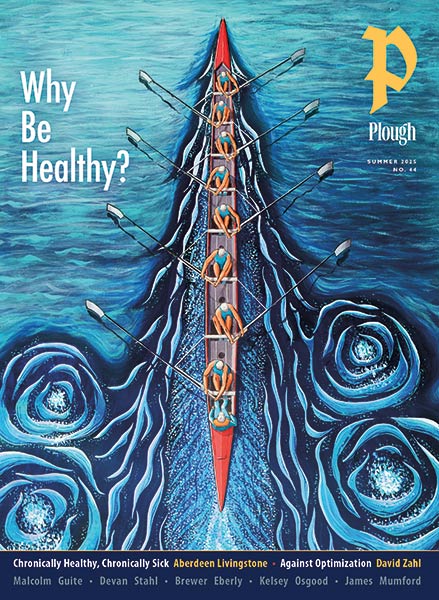Subtotal: $
Checkout
The World Turned Right-Side Up
Was Saint Paul’s famous “thorn in the flesh” a disability?
By Isaac T. Soon
February 11, 2022
Next Article:
For most of Western history, at least from the fourth century BC to the thirteenth century AD, philosophers and doctors believed that the phenomenon of “seeing” happened when light came out of our eyes to illuminate the world around us. Plato, in his Timaeus, argued that the fire in our eyes combined with the fire of the sun to “touch” objects around us. This incandescent intimacy allows our souls to apprehend the world. From this perspective, a sighted person’s visual assessment of another person – the first glance – is also the first time one reaches out and touches the other.
The very first things that people who are sighted notice about those we meet for the first time are the things most readily available to our visual sense. Eye color. Skin color. Height. Weight. Clothing. Our eyes overload our brains with visual data, and before we know it our neurons are intoxicated with information about the other person.
The way women’s bodies are presented on billboards and on the feeds of influencers, devoid of blemish and bursting with exaggerated color, testifies to the power of the human gaze. Do you have a mark on your skin? We’ve got a filter for that. Do you want to look forty years younger? Not a problem. Vibrancy is vivacity, and the eyes never lie. Bodies must be perfected lest, God forbid, the viewer might turn away. And if they turn away, they don’t buy anything. They don’t follow. They don’t press “subscribe.”

All photography by Joe James Used by permission.
But whom we should follow is not always as apparent to a first glance as we might hope. The eye is a fickle instrument. People, like books, shouldn’t be judged by how they appear.
The human ability to measure up the whole of a person in a glance is truly remarkable and terrible. They’re wearing [insert clothing], they must be rich. Their skin is [insert color], I don’t feel safe around them. They are [insert weight observation], they must be lazy.
Judging others by physical appearance is not a recent development. In the ancient Mediterranean world, people from Athens to Rome and Qumran to Asia Minor assessed the characters of other people by aspects of their bodies, by their physiognomies. Aristotle explored the idea in his Prior Analytics and commented in the Generation of Animals on practitioners who attributed meaning to a resemblance to a calf or a sheep. There were handbooks that cataloged all sorts of physical features and what they signified: Someone with a head of waving tawny hair might be proud as a lion. Someone with a big nose was probably wealthy, literally or in spirit.
Determining the value of other people’s bodies, however, was not reserved only for those who consulted physiognomic handbooks. Ancient literature, dinnerware, mosaics, statues, and many other kinds of visual culture all pushed particular bodily ideals. They were a sort of physiognomic propaganda, putting ideal bodies in heroic postures and denigrating the less than perfect as barbaric, animalistic, and laughable. The beautiful was the good. The unbeautiful, the immoral.
Paul the Apostle struggled with the bodily ideals of his own world. His Letter to the Galatians explains why circumcision is not beneficial for non-Jewish believers. His correspondence with the assemblies in Corinth includes consideration of his own weak body.
In Paul’s Second Letter to the Corinthians, he responds to members of the congregations who have called his speech “contemptible” and said that his bodily presence is weak (2 Cor. 10:10). In comparison to a group of “super-apostles” (2 Cor. 11:5), Paul lacks the kind of physical finesse and charisma the Corinthians were used to seeing among philosophers and sophists. But rather than explain away his poor speaking skills and weak body, Paul doubles down and instead boasts about the experiences of his suffering in greater detail. He has been stoned by synagogue authorities, beaten by the rods of the Roman fasces, wrecked at sea, left starving and naked and cold and anxious. Even his alleged divinatory and prophetic skills – his ability to ascend into the heavens – are muted and he is unable to reveal divine oracles he has heard in paradise.

In comparison to many bodily ideals of the day, Paul’s body appeared weak, diminished, and slavish. As the work of Jennifer Glancy has shown, bodily scars such as those mentioned by Paul in Galatians 6:17 meant different things, depending on how and why they were acquired. A soldier returning from glorious battle with scars and lacerations on the front of his body bore marks of bravery, courage, and honor. Wounds on his back, however, might imply retreat and cowardice. Paul’s scars were the marks of beatings: that is, of criminality or enslavement. In the wider pagan world, Paul’s “marks of Christ” cast him as servile and an enemy of the state. Suddenly, the caution of the Corinthian congregations makes sense. Why should they trust someone who looked like that?
The details of Paul’s battered body were not the only problematic aspects of his physique. The famous “thorn in the flesh” mentioned in 2 Corinthians 12:7–10 has tested the exegetical ingenuity of interpreters for hundreds of years. A head injury, malaria, blindness, depression, even lust – all have been suggested. No single explanation has garnered lasting support.
Inasmuch as there is scholarly agreement about this, however, that agreement points to the thorn as a literal phenomenon that afflicted Paul’s actual body. Tempting as it may be to take his words as metaphorical, the phrase “in the flesh” most likely refers to the location of this thorn: Paul’s body is in pain. But that affliction turns out to be a gift from God.
In recent years one of the ways that commentators have spoken of this affliction has been in the language of disability. Although some contemporary implications of the term “disability” are culturally specific, the reality of conditions that depart from ideal bodily forms and functions exists in all cultures.
Three times, Paul petitions God to heal him, to remove the thorn, and three times God says no. How could he refuse? God entrusted his precious gospel to the Gentiles to Paul, and Paul had suffered so much along the way. Surely, “health” and “wholeness” are necessary for him to complete his divine mandate? To Paul’s shock, the opposite is true. When he turns to God for healing, he receives no reprieve. It is not as though Paul acts outside of what was common practice at the time. Most people went to temples of healing, seeking gods like Aesculapius to restore their bodies from the ailments that plagued them. Paul goes to the most powerful God he knows – the God of Israel – but no respite from his disability is given.
Rather, God says that his power is perfected in weakness.
From then on Paul’s tune changes. He stops asking for “healing” and instead boasts of his “weakness.” In 2 Corinthians 12:10, he makes a bold and paradoxical statement: “For when I am weak, then I am strong.” This phrase baffles interpreters. In what way is weakness strength? Is it merely a change of perception? A kind of “self-help” mantra, to manifest a good life, a “word of faith” speaking things into being? Or is it a reality, a changing of the very nature of things? Paul may mean a little bit of both.

The paradox of power in weakness finds its significance in the paradox of Jesus’ death through crucifixion as life-giving and miraculous (2 Cor. 4). The crucified Messiah is for Paul the symbol of divine victory over the forces of sin and death. For everyone else, Jew and non-Jew, this weakness of the cross was a shame and a scandal. The same goes for Paul’s thorn. To the whole world, his disability is a mark against his life and the power of the God he serves. But for Paul, his disability is the locus of God’s power. It is where God’s power is most at work.
Paul does not merely trade labels between what is strong and what is weak. He is not simply re-branding his condition. The revelation Paul has is that, though the world understands his disability as weakness, he has come to realize that it is actually powerful. It is not to be done away with, or put to the side, or remedied through physical healing. Paul’s disability is essential for the mission that God has set out for him. Not only that, however, but disability more generally is absolutely central to faith in Jesus Christ. Disability is the crux of Paul’s gospel message.
In the life and body of the man whose job it was to bring the gospel to the nations, physical disability was a crucial and honorable witness to God’s own strength. Paul’s life was an inversion of cultural notions that presumed human existence without pain and suffering was the divine ideal. It is instructive to remember, too, that even in Christ’s own glorified body, his wounds remain – no longer a source of suffering but a sign of victory.
Paul’s paradox of power in weakness puts disability right where it belongs. Disability isn’t at the margins. It’s not liminal. It doesn’t dwell in the interstitial spaces. It is at the center. It brings everything together. To remove disability from Christ was to remove the scandal of the cross, and while his pagan interlocutors would no doubt have found this paradox to be nonsense – a world turned upside down – for Paul the role of God’s power in weakness was a sign that the world had been finally turned right-side up.
About the photographer: Joe James took up photography to combat depression after he discovered he was autistic at age thirty-two. As he found, “Photography didn’t save me from being autistic, it saved me from my anxiety.” Joe now sees his autism as a gift that allows him to view the world through a different lens, and online he goes by the name of “Joe James the Autistic Photographer.” “I love photography, it’s my art, my expression, it gives me another type of voice, to show visually how I feel,” he explains. “Through my pictures I can show people how I feel because a lot of the time I can’t really express myself. Especially over social media. This is how I interpret what I see. This is where I find beauty.”
Already a subscriber? Sign in
Try 3 months of unlimited access. Start your FREE TRIAL today. Cancel anytime.







Laurely
I thought you might like to see this article. It reminded me of some of our conversations on Gods power being made perfect on our weakness.
Justin Hawkins
At the end of his “The World Turned Right-Side Up” (Winter 2022), Prof. Isaac T. Soon noted that “even in Christ’s own glorified body, his wounds remain — no longer a source of suffering but a sign of victory.” This brief observation contains multitudes, and ought to be the starting point for theological reflection upon the significance of both physical and cognitive handicaps. Historically it has been; Nancy Eiesland’s The Disabled God (1994) inaugurated a tradition of seeing the glorified wounds of Christ as evidence of his solidarity with the disabled. Centuries prior, both Aquinas and Augustine claimed that Christ’s glorified wounds implied the martyrs would likewise be risen with their wounds, for, as Augustine argued, “we shall see on the bodies of the martyrs the traces of the wounds which they bore for Christ’s name, because they will not be a deformity, but a dignity in them; and a certain kind of beauty will shine in them.” But martyrs are not the only saints who bear in their bodies the marks of a long faithfulness to Christ under duress and oppression. While the distinctive mark of the martyr is suffering, disability cannot be understood only as an instance of pain, weakness, or suffering. Not all disabled people suffer pain from their handicaps. Some suffer far more from forms of societal exclusion and stigma than from anything happening within their bodies. But theological reflection upon Christ’s “rich wounds / yet visible above, in beauty glorified,” permits Christians to see, even now, dignity rather than deformity in those with both physical and cognitive impairments. It is by now common for disability advocates, activists, and theorists to insist that disabilities ought not be understood as objects for cure. After all, what would it mean to “cure" a person’s Down Syndrome without thereby annihilating the person and personality who bears that Down Syndrome? Instead, Christian theology insists that their bodies, along with the bodies of the typically abled, await not mere cure, but glorification. But there is yet one further entailment of Prof. Soon’s insight. If the wounded and scarred Christ is the norm of the resurrection, then we have good reason to think those with able body and sound mind, those not typically classed among the disabled and the impaired, will likewise undergo a transformation by which they will eschatologically and everlastingly bear more conspicuously in their bodies the evidence and effects of human contingency, the sorrows and struggles of long faithfulness under duress. After all, Paul insists that we shall all be changed. God requires no more miracles to resurrect and glorify the body of a person with Down Syndrome than are necessary to resurrect and glorify any non-disabled person. Conformity to Christ means conformity to his scars. To the degree that the able-bodied receive this as a curse and not a blessing, to that same degree must we hear anew and again that our wounds are, even now, albeit through a glass darkly, a source of dignity and not deformity.